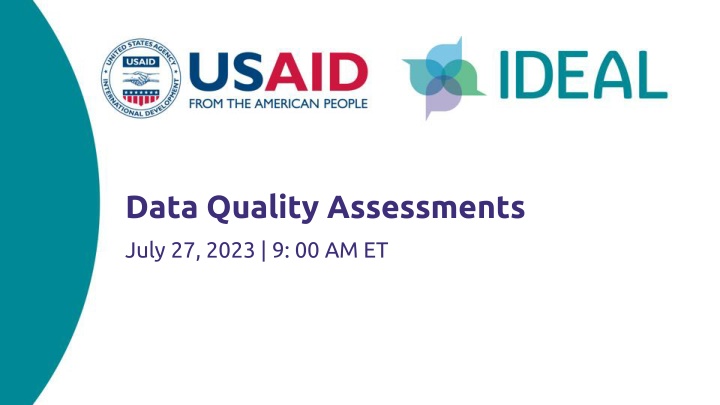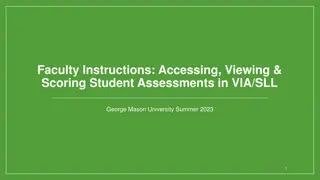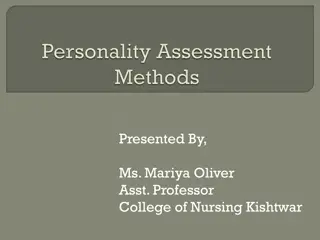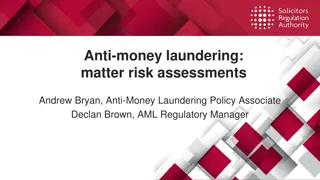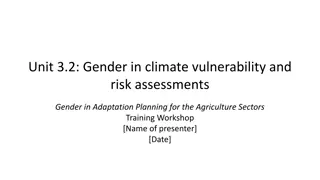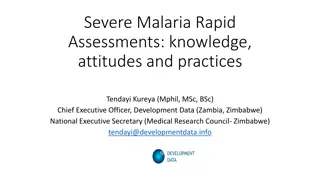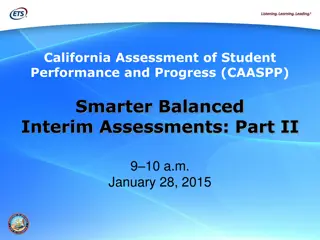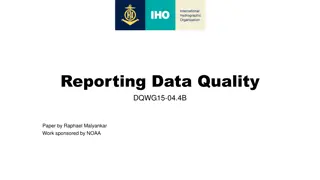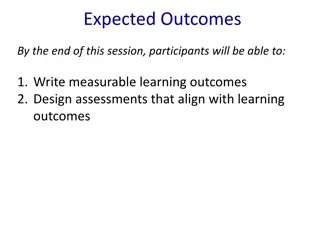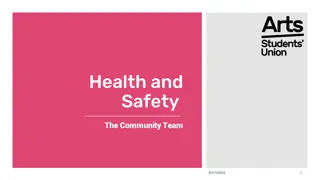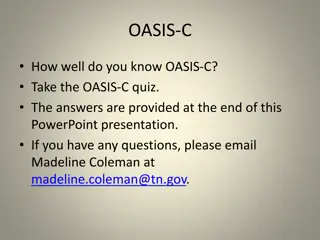Data Quality Assessments
The International Medical Corps (IMC) introduces a new guide and tool for Research, Data Quality Assessments (RDQA) to enhance data quality practices in humanitarian settings. Led by IMC's M&E Unit, the comprehensive tool provides step-by-step instructions for assessing and scoring data quality, addressing key challenges in implementing RDQAs. The guide, developed over two years and rolled out in 2023, offers insights into levels of data assessed, common data quality issues, scoring approaches, ethical considerations, and more. Join the discussion on the recent developments and practical applications of the RDQA guide at IMC.
Download Presentation

Please find below an Image/Link to download the presentation.
The content on the website is provided AS IS for your information and personal use only. It may not be sold, licensed, or shared on other websites without obtaining consent from the author.If you encounter any issues during the download, it is possible that the publisher has removed the file from their server.
You are allowed to download the files provided on this website for personal or commercial use, subject to the condition that they are used lawfully. All files are the property of their respective owners.
The content on the website is provided AS IS for your information and personal use only. It may not be sold, licensed, or shared on other websites without obtaining consent from the author.
E N D
Presentation Transcript
Data Quality Assessments July 27, 2023 | 9: 00 AM ET
Best Practices Activate your video when you are speaking, if possible. Mute your microphone when you are not speaking. During Q&A, raise your hand if you d like to speak out loud. Use the chat box if you have any questions or comments!
Next Webinar Date: Early September Theme: Outcome Measurement in Humanitarian Settings Format: Panel discussion Interested in being a panelist or have a discussion question to contribute? Share contacts and questions via this form or reach out to humelmanagement@gmail.com.
Agenda Developments in RDQA at International Medical Corps, lebanon Case Study (20 min, 10 min Q&A) DQA for Feedback Complaints and Response Mechanism in Moldova (20 min, 10 min Q&A) Photo Credit Shashank Shrestha/Save the Children
Developments in RDQA at International Medical Corps Jennifer Majer, Sr Advisor, MEAL and Research, IMC HQ Omar Makki, MEAL Officer, IMC Lebanon
Agenda New IMC guidance document and tool for conducting RDQAs IMC Lebanon country team s experience with RDQA Photo Credit: Jonathan Hyams/Save the Children Photo Credit Jonathan Hyams/Save the Children
IMC Guide and Tool for RDQA The guide is designed for staff in IMC program offices to reference when planning and implementing RDQAs. It provides step-by-step instructions and a tool to systematically assess and score data quality. Contents Objectives and key concepts in RDQA Levels of data assessed Types of data quality issues Key steps to implementing RDQA Scoring approach Ethical considerations Recommended tool
Development and Roll-Out RDQA Guide and Tool took around two years to fully develop and were completed in May 2023. Development process was led by IMC s M&E Unit in HQ, with input from Technical Unit advisors on sector-specific data considerations. Complexities regarding Level 1 data (individual patient/client records) needed to be worked through in developing the guide. Rolled out to country teams through two orientation webinars in June and July 2023.
Levels of data & areas of focus Level 1: Individual beneficiary records Level 2: Aggregated data Reviewing data collection and management systems to ensure alignment of recorded data and reporting tools. Aggregated data should match the disaggregated data in facilities, project sites, record keeping books, etc. Note: For reporting, IMC aggregates all records of activity into the IPTT as a single data source for each grant. However, each mission may also employ several intermediary level 2 data tools (typically Excel tracker spreadsheets, DHIS2 in some cases) before data reaches the IPTT. Reviewing beneficiary records to ensure that all pertinent data have been correctly recorded. With health services, for example, checking the front sheet or online patient records to ensure that the patient s presenting problems, diagnosis and treatment have been recorded and are supported by documentation in the body of the medical record.
Implementation of the RDQA and key steps Step 1 Determine Frequency of RDQA Step 2 Select indicators for the RDQA The selection of indicators is often done by categorizing indicators (by outcome/output, based on data flows, program area importance, indicators with suspected data quality issues, etc.) and drawing a sample of indicators for each category and a sample of sites to conduct the DQA. BHA highlights potential considerations that can be taken into account when identifying indicators to include in the RDQA: Indicators that are complicated to measure Indicators of suspect data quality Indicators of high importance to decision making Indicators that demonstrate an intervention s progress Indicators that represent different data flow processes Step 3 & 4 - Identify data sources for selected indicators & Timeframe
Implementation of the RDQA and key steps Step 5 Determine sample size Review reported numbers from a quarterly or semi-annual report with IPTT and then with aggregated data to ensure data is the same across all the sources. The team can select a few sites where they are realistically able to check both level 2 and level 1 data. The team can select a handful of sites and review numbers as a spot check . The technical staff in the audit team can also check the quality of measurements and recording in hard copy files at the field sites to get an impression of overall data quality issues that may be plaguing other locations not part of the audit.
Implementation of the RDQA and key steps Step 6 & 7 Determine appropriate staff responsibilities for checks & Inform team of visit Step 8 - Conduct the review (site visit and document review) using the appropriate tools and checklists
Ratings This is the typical rating scale for points. So if you mark something excellent in the tool, it would give 3 points for that sub-section.
Implementation of the RDQA and key steps Step 9 Data entry & Analysis Step 10 Draft report (Optional) Step 11 Discuss findings Step 12 Develop a tracking plan for remedial action
Country Case Example of RDQA: LEBANON
Background We initiated the DQA to ensure the reliability of our data, particularly the BHA KPIs. The aim was to identify areas for improvement, strengthen our data reporting processes, and optimize our program outcomes based on reliable data. We decided to start with the BHA KPIs related to health consultations. Photo Credit Kelley Lynch
Site Selection The PHCC handles an average volume of patients and plays a crucial role in NCD consultations. The PHCC is easily accessible for the assessment team and ensured smooth logistics and timely data collection. The PHCC demonstrated a willingness to participate in the assessment and collaborate with our team.
Findings Demonstrating the strength of our current practices in maintaining good data quality. Identification of a robust system for regular data quality assurance review. Findings were both communicated to relevant staff and are being tracked for improvements. This includes the development of a data cleaning Standard Operating Procedure (SOP) to further enhance our data quality.
Lessons Learned The significance of teamwork and cross-departmental collaboration in driving data quality improvements. The DQA process has reinforced our commitment to ongoing learning and quality improvement. The importance of having dedicated data quality assurance staff who review data on a regular basis. The efficiency of our monitoring tools We also learned the benefits of starting with basic indicators and applying lessons learned to improve more complex KPIs.
Q&A For further questions: Jennifer Majer jlmajer@internationalmedicalcorps.org Omar Makki omakki@internationalmedicalcorps.org This presentation is made possible by the generous support of the American people through the United States Agency for International Development (USAID). The contents are the responsibility of the Implementer-led Design, Evidence, Analysis and Learning (IDEAL) Activity and do not necessarily reflect the views of USAID or the United States Government.
DQA for Feedback Complaints and Response Mechanism in Moldova Catholic Relief Services (CRS) Wilson Gu, MEAL Technical Advisor
Project Details Cash distribution project led by UNHCR started in March 2022 At the highest, 115,000+ approximate individuals benefited from cash distribution CRS, Caritas Moldova, Diaconia are jointly implementing partners Provide staff at enrollment centers services related to cash distribution registration, verification, card distribution, and troubleshooting Also operated helpline - 12 operators
Standard Definition Validity Are the data appropriately categorized/is feedback sufficiently captured/do beneficiaries have adequate access to give feedback?
Standard Definition Validity Are the data appropriately categorized/is feedback sufficiently captured/do beneficiaries have adequate access to give feedback? Reliability Are data collection processes and analysis methods consistent over time?
Standard Definition Validity Are the data appropriately categorized/is feedback sufficiently captured/do beneficiaries have adequate access to give feedback? Reliability Are data collection processes and analysis methods consistent over time? Timeliness Are feedbacks responded to in a sufficiently timely fashion/Is the data analyzed and used for decision making in a timely fashion?
Standard Definition Validity Are the data appropriately categorized/is feedback sufficiently captured/do beneficiaries have adequate access to give feedback? Reliability Are data collection processes and analysis methods consistent over time? Timeliness Are feedbacks responded to in a sufficiently timely fashion/Is the data analyzed and used for decision making in a timely fashion? Precision Do the data have a sufficient level of detail to permit management decision-making?
Standard Definition Validity Are the data appropriately categorized/is feedback sufficiently captured/do beneficiaries have adequate access to give feedback? Reliability Are data collection processes and analysis methods consistent over time? Timeliness Are feedbacks responded to in a sufficiently timely fashion/Is the data analyzed and used for decision making in a timely fashion? Precision Do the data have a sufficient level of detail to permit management decision-making? Integrity Do data collected have safeguards to minimize the risk of data entry error, data manipulation, and exposure of sensitive information?
FCRM standard operating procedures (SOPs) make it easier to assess data quality.
In-person monitoring of operators actions for a DQA can generate insights.
CommCare and a Power BI dashboard make it easier to assess data quality.
Identify opportunities for triangulation prior to assessing data quality.
SOP person Power BI
Q&A For further questions: Wilson Gu wilson.gu@crs.org This presentation is made possible by the generous support of the American people through the United States Agency for International Development (USAID). The contents are the responsibility of the Implementer-led Design, Evidence, Analysis and Learning (IDEAL) Activity and do not necessarily reflect the views of USAID or the United States Government.
Thank you! Questions? Contact HuMEL Management at humelmanagement@gmail.com This presentation is made possible by the generous support of the American people through the United States Agency for International Development (USAID). The contents are the responsibility of the Implementer-led Design, Evidence, Analysis and Learning (IDEAL) Activity and do not necessarily reflect the views of USAID or the United States Government.
